Impact of Stationary and Dynamic Conditions on the U-Value Measurements of Heavy-Multi Leaf Walls by Quantitative IRT
Abstract
:1. Introduction
2. Background: Thermal Diagnosis of Building Components
2.1. Assessment of the U-Value Using the HFM
2.2. Assessment of the U-Value Using the Quantitative IRT
2.2.1. Quantitative Infrared Thermography under Steady-State Conditions
2.2.2. Quantitative Infrared Thermography under Dynamic Conditions
3. Materials and Methods
3.1. Laboratory Testing under Steady-State Conditions
3.2. In Situ Testing under Dynamic Conditions
4. Results
4.1. Laboratory Testing under Steady-State Conditions
4.2. In Situ Testing under Dynamic Conditions
5. Discussions and Conclusions
Author Contributions
Funding
Conflicts of Interest
Nomenclature
| HFM | Heat Flux Meter |
| QIRT | Quantitative Infrared Thermography |
| LAB | Laboratory |
| DH | Detached House |
| ∆xi | Thickness of the material layer [m] |
| λi | Thermal conductivity of the material layer [W/(m·K)] |
| Rt i | Theoretical R-value of the material layer [(m2·K)/W] |
| Ut | Theoretical U-value [W/m2·K] |
| Umes i | Instantaneous measured U-value [W/m2·K] |
| Umes avg | Average measured U-value [W/m2·K] |
| TIN | Inner ambient air temperature [K] |
| RHIN | Inner relative humidity [%] |
| TOUT | Outer ambient air temperature [K] |
| RHOUT | Outer relative humidity [%] |
| TWALL | Wall surface temperature [K] |
| TREF | Reflected ambient temperature [K] |
| εWALL | Wall surface emissivity |
| qc | specific heat flux by convection using QIRT [W/m2] |
| qr | specific heat flux by radiation using QIRT [W/m2] |
| σ | Stefan-Boltzmann’s constant (σ = 5.67 × 10−8 [W/m2 K4]) |
| λair | air thermal conductivity [W/(m·K)] |
| L | wall height seen from the internal side of the wall [m] |
| n | total number of thermograms |
| Ra | Rayleigh number () |
| Pr | Prandtl numbers (Pr = 0.73 for TIN = 20–25 °C) |
| g | gravitation (9.8m/s2) |
| β | volumetric temperature expansion coefficient (1/Tm where Tm is the average value of TIN and TWALL) |
| v | air viscosity (v = 1.5 × 10−5 m2/s for TIN = 15–25 °C) |
| qHFM | Total heat flux using HFM [W/m2] |
| X | Measured voltage signal from the sensor [mV] |
| CHFM | Numerical constant of the sensor provided by the manufacturer [W/m2·mV] |
| hIN | Total heat transfer coefficient from inner side [W/m2·K] |
| ∆U IRT −t/Ut | Relative deviation between the theoretical U-value and the measured U-value using QIRT |
| ∆U HFM –t/Ut | Relative deviation between the theoretical U-value and the measured U-value using HFM |
| ∆UNDT/UHFM | Relative deviation between both NDT techniques (HFM and QIRT), taking as reference the standardized method |
References
- Nardi, I.; Lucchi, E.; De Rubeis, T.; Ambrosini, D. Quantification of heat energy losses through the building envelope: A state-of-the-art with critical and comprehensive review on infrared thermography. Build. Environ. 2018, 146, 190–205. [Google Scholar] [CrossRef] [Green Version]
- Evola, G.; Marletta, L.; Costanzo, V.; Caruso, G. Different strategies for improving summer thermal comfort in heavyweight traditional buildings. Energy Procedia 2015, 78, 3228–3233. [Google Scholar] [CrossRef] [Green Version]
- Lucchi, E. Applications of the infrared thermography in the energy audit of buildings: A review. Renew. Sustain. Energy Rev. 2018, 82, 3077–3090. [Google Scholar] [CrossRef]
- American Society for Testing Materials. ASTM C1060-90. Standard Practice for Thermographic Inspection of Insulation Installations in Envelope Cavities of Frame Buildings; American Society for Testing Materials: West Conshohocken, PA, USA, 2003. [Google Scholar]
- International Organization for Standardization. ISO 6781-3:2015. Performance of Buildings. Detection of Heat, Air and Moisture Irregularities in Buildings by Infrared Methods—Part 3: Qualifications of Equipment Operators, Data Analysts and Report Writers; International Organization for Standardization: Geneva, Switzerland, 2015. [Google Scholar]
- International Organization for Standardization. UNE EN 13187:1998. Thermal Performance of Buildings. Qualitative Detection of Thermal Irregularities in Building Envelopes. Infrared Method; International Organization for Standardization: Geneva, Switzerland, 1998. [Google Scholar]
- International Organization for Standardization. ISO 9869-2: 2018 Thermal Insulation—Building Elements—In-Situ Measurements of Thermal Resistance and Thermal Transmittance. Part 2: Infrared Method for Frame Structures Dwelling; International Organization for Standardization: Geneva, Switzerland, 2018. [Google Scholar]
- International Organization for Standardization. ISO 9869-1:2014 Thermal Insulation. Building Elements. In–Situ Measurement of Thermal Resistance and Thermal Transmittance. Part 1: Heat Flow Meter Method; International Organization for Standardization: Geneva, Switzerland, 2014. [Google Scholar]
- Gaspar, K.; Casals, M.; Gangolells, M. A comparison of standardized calculation methods for in situ measurements of façades U-value. Energy Build. 2016, 130, 592–599. [Google Scholar] [CrossRef]
- Kisilewicz, T. Thermal resistance of a wall determined in non-stationary boundary conditions. In Proceedings of the 1st Central European Symposium on Building Physics, Research on Building Physics, Kraków-Łódź, Poland, 13–15 September 2010; pp. 171–176, ISBN 978-83-7283-367-9. [Google Scholar]
- International Organization for Standardization. ISO 13786: 2017. Thermal Performance of Building Components—Dynamic Thermal Characteristics—Calculation Methods; International Organization for Standardization: Geneva, Switzerland, 2017. [Google Scholar]
- Kossecka, E. Problem of the measured R-value error estimation. Arch. Civ. Eng. 1993, 39, 413–427. [Google Scholar]
- Evangelisti, L.; Guattari, C.; Gori, P.; Vollaro, R.D.L.; Asdrubali, F. Experimental investigation of the influence of convective and radiative heat transfers on thermal transmittance measurements. Int. Commun. Heat Mass Transf. 2016, 78, 214–223. [Google Scholar] [CrossRef]
- International Organization for Standardization. UNE EN ISO 6946:2012 (ISO 6946:2007) Building Components and Building Elements. Thermal Resistance and Thermal Transmittance. Calculation Method; International Organization for Standardization: Geneva, Switzerland, 2012. [Google Scholar]
- Evangelisti, L.; Guattari, C.; Asdrubali, F. Influence of heating systems on thermal transmittance evaluations: Simulations, experimental measurements and data post-processing. Energy Build. 2018, 168, 180–190. [Google Scholar] [CrossRef]
- Atsonios, I.A.; Mandilaras, I.; Kontogeorgos, D.A.; Founti, M.A. A comparative assessment of the standardized methods for the in–situ measurement of the thermal resistance of building walls. Energy Build. 2017, 154, 198–206. [Google Scholar] [CrossRef]
- Marino, B.M.; Muñoz, N.; Thomas, L.P. Estimation of the surface thermal resistances and heat loss by conduction using thermography. Appl. Therm. Eng. 2017, 114, 1213–1221. [Google Scholar] [CrossRef]
- Kisilewicz, T.; Wróbel, A. Quantitative infrared wall inspection. In Proceedings of the 2010 International Conference on Quantitative InfraRed Thermography, Quebec, ON, Canada, 24–29 June 2010; pp. 589–594. [Google Scholar] [CrossRef]
- Lucchi, E.; Roberti, F.; Alexandra, T. Definition of an experimental procedure with the hot box method for the thermal performance evaluation of inhomogeneous walls. Energy Build. 2018, 179, 99–111. [Google Scholar] [CrossRef]
- Tejedor, B.; Casals, M.; Gangolells, M.; Roca, X. Quantitative internal infrared thermography for determining in-situ thermal behaviour of façades. Energy Build. 2017, 151, 187–197. [Google Scholar] [CrossRef]
- Albatici, R.; Tonelli, A.M. Infrared thermovision technique for the assessment of thermal transmittance value of opaque building elements on site. Energy Build. 2010, 42, 2177–2183. [Google Scholar] [CrossRef]
- Fokaides, P.A.; Wongwises, S. Application of infrared thermography for the determination of the overall heat transfer coefficient (U-Value) in building envelopes. Appl. Energy 2011, 88, 4358–4365. [Google Scholar] [CrossRef]
- Dall’O’, G.; Sarto, L.; Panza, A. Infrared Screening of Residential Buildings for Energy Audit Purposes: Results of a Field Test. Energies 2013, 6, 3859–3878. [Google Scholar] [CrossRef] [Green Version]
- Nardi, I.; Sfarra, S.; Ambrosini, D. Quantitative thermography for the estimation of the U-value: State of the art and a case. J. Phys. Conf. Ser. 2014, 547. [Google Scholar] [CrossRef]
- Danielski, I.; Fröling, M. In-situ measurements of thermal properties of building fabrics using thermography under non-steady state heat flow conditions. Infrastructures 2018, 3, 20. [Google Scholar] [CrossRef] [Green Version]
- Bienvenido-Huertas, D.; Moyano, J.; Marín, D.; Fresco-Contreras, R.; Marín-García, D. Review of in situ methods for assessing the thermal transmittance of walls. Renew. Sustain. Energy Rev. 2019, 102, 356–371. [Google Scholar] [CrossRef]
- Asdrubali, F.; Baldinelli, G.; Bianchi, F. A quantitative methodology to evaluate thermal bridges in buildings. Appl. Energy 2012, 97, 365–373. [Google Scholar] [CrossRef]
- Ficco, G.; Iannetta, F.; Ianniello, E.; Alfano, F.R.D.; Dell’Isola, M. U-value in situ measurement for energy diagnosis of existing buildings. Energy Build. 2015, 104, 108–121. [Google Scholar] [CrossRef]
- Nardi, I.; Paoletti, D.; Ambrosini, D.; De Rubeis, T.; Sfarra, S. Validation of quantitative IR thermography for estimating the U-value by a hot box apparatus. J. Physics: Conf. Ser. 2015, 655, 012006. [Google Scholar] [CrossRef]
- Nardi, I.; Ambrosini, D.; De Rubeis, T.; Sfarra, S.; Perilli, S.; Pasqualoni, G. A comparison between thermographic and flow-meter methods for the evaluation of thermal transmittance of different wall constructions. J. Physics: Conf. Ser. 2015, 655, 012007. [Google Scholar] [CrossRef] [Green Version]
- Nardi, I.; Paoletti, D.; Ambrosini, D.; De Rubeis, T.; Sfarra, S. U-value assessment by infrared thermography: A comparison of different calculation methods in a Guarded Hot Box. Energy Build. 2016, 122, 211–221. [Google Scholar] [CrossRef]
- Tejedor, B.; Casals, M.; Gangolells, M. Assessing the influence of operating conditions and thermophysical properties on the accuracy of in-situ measured U -values using quantitative internal infrared thermography. Energy Build. 2018, 171, 64–75. [Google Scholar] [CrossRef]
- Tejedor, B.; Casals, M.; Macarulla, M.; Giretti, A. U-value time series analyses: Evaluating the feasibility of in-situ short-lasting IRT tests for heavy multi-leaf walls. Build. Environ. 2019, 159, 106123. [Google Scholar] [CrossRef]
- Tejedor, B.; Barreira, E.; Almeida, R.M.; Casals, M. Thermographic 2D U-value map for quantifying thermal bridges in building façades. Energy Build. 2020, 224, 110176. [Google Scholar] [CrossRef]
- International Organization for Standardization. UNE EN 1934:1998 Thermal Performance of Buildings—Determination of Thermal Resistance by Hot Box Method Using Heat Flow—Masonry; International Organization for Standardization: Geneva, Switzerland, 1998. [Google Scholar]
- Lucchi, E. Thermal transmittance of historical stone masonries: A comparison among standard, calculated and measured data. Energy Build. 2017, 151, 393–405. [Google Scholar] [CrossRef]
- Lehmann, B.; Wakili, K.G.; Frank, T.; Collado, B.V.; Tanner, C. Effects of individual climatic parameters on the infrared thermography of buildings. Appl. Energy 2013, 110, 29–43. [Google Scholar] [CrossRef]
- Danielski, I.; Fröling, M. Diagnosis of Buildings’ Thermal Performance—A Quantitative Method Using Thermography Under Non-steady State Heat Flow. Energy Procedia 2015, 83, 320–329. [Google Scholar] [CrossRef] [Green Version]
- Aversa, P.; Palumbo, D.; Donatelli, A.; Tamborrino, R.; Ancona, F.; Galietti, U.; Luprano, V.A.M. Infrared thermography for the investigation of dynamic thermal behaviour of opaque building elements: Comparison between empty and filled with hemp fibres prototype walls. Energy Build. 2017, 152, 264–272. [Google Scholar] [CrossRef]
- International Organization for Standardization. 2012. UNE EN ISO 10456:2012 Building Materials and Products—Hygrothermal Properties—Tabulated Design Values and Procedures for Determining Declared and Design Thermal Values; International Organization for Standardization: Geneva, Switzerland, 2012. [Google Scholar]
- AVIO Systems. InfRec Analyzer Software. 2015. Available online: https://www.infrared.avio.co.jp/en/support/thermo/download/ns9500lt-dl/index.html (accessed on 14 December 2020).
- FLIR Systems. FLIR TOOLS+ Software. 2015. Available online: https://www.flir.com/products/flir-tools/ (accessed on 14 December 2020).
- Asdrubali, F.; D’Alessandro, F.; Baldinelli, G.; Bianchi, F. Evaluating in situ thermal transmittance of green buildings masonries: A case study. Case Stud. Constr. Mater. 2014, 1, 53–59. [Google Scholar] [CrossRef]
- RESNET—Residential Energy Services Network. RESNET Interim Guideline for Thermographic Inspections of Buildings. Available online: http://www.resnet.us/standards/RESNET_IR_interim_guidelines.pdf (accessed on 20 October 2020).

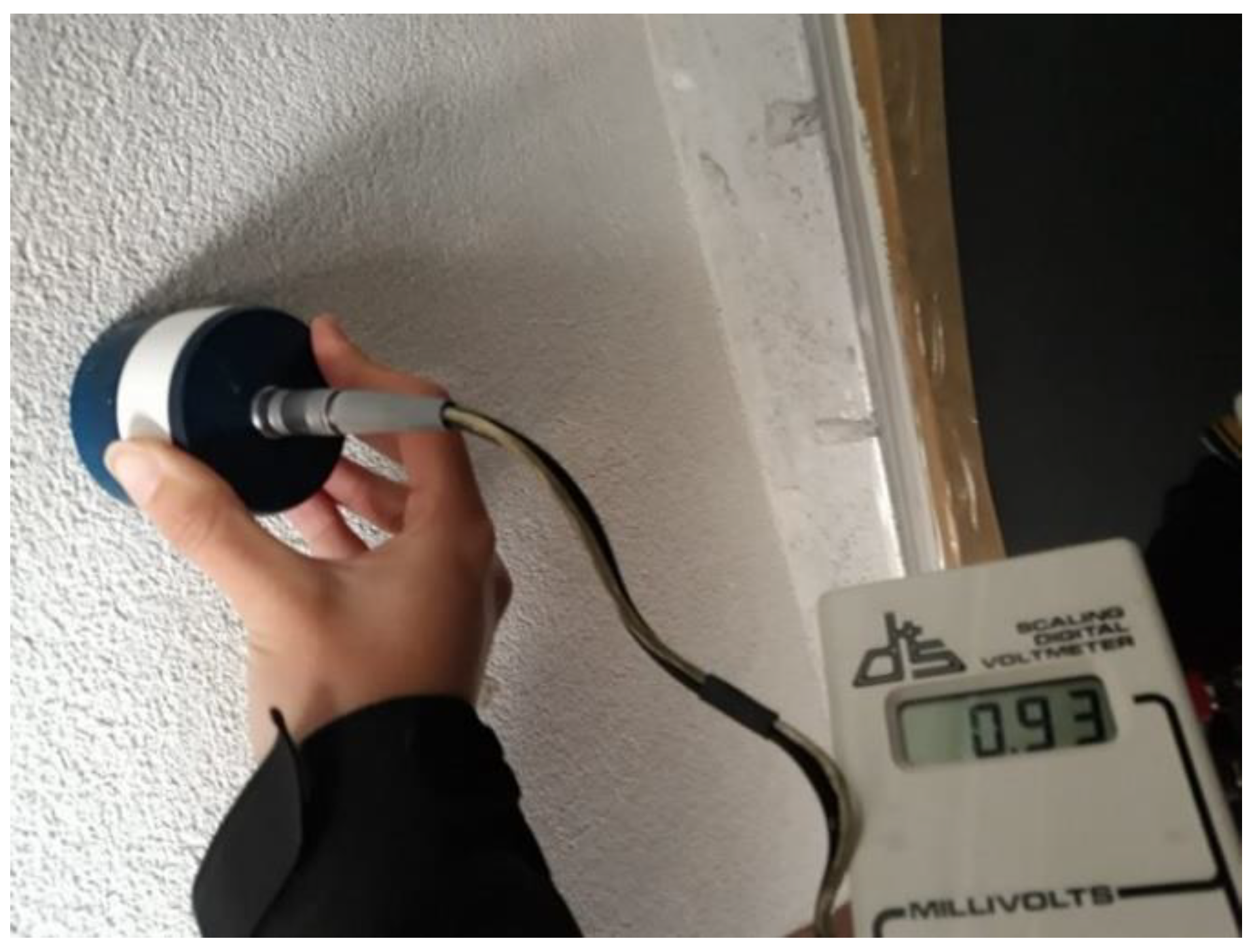
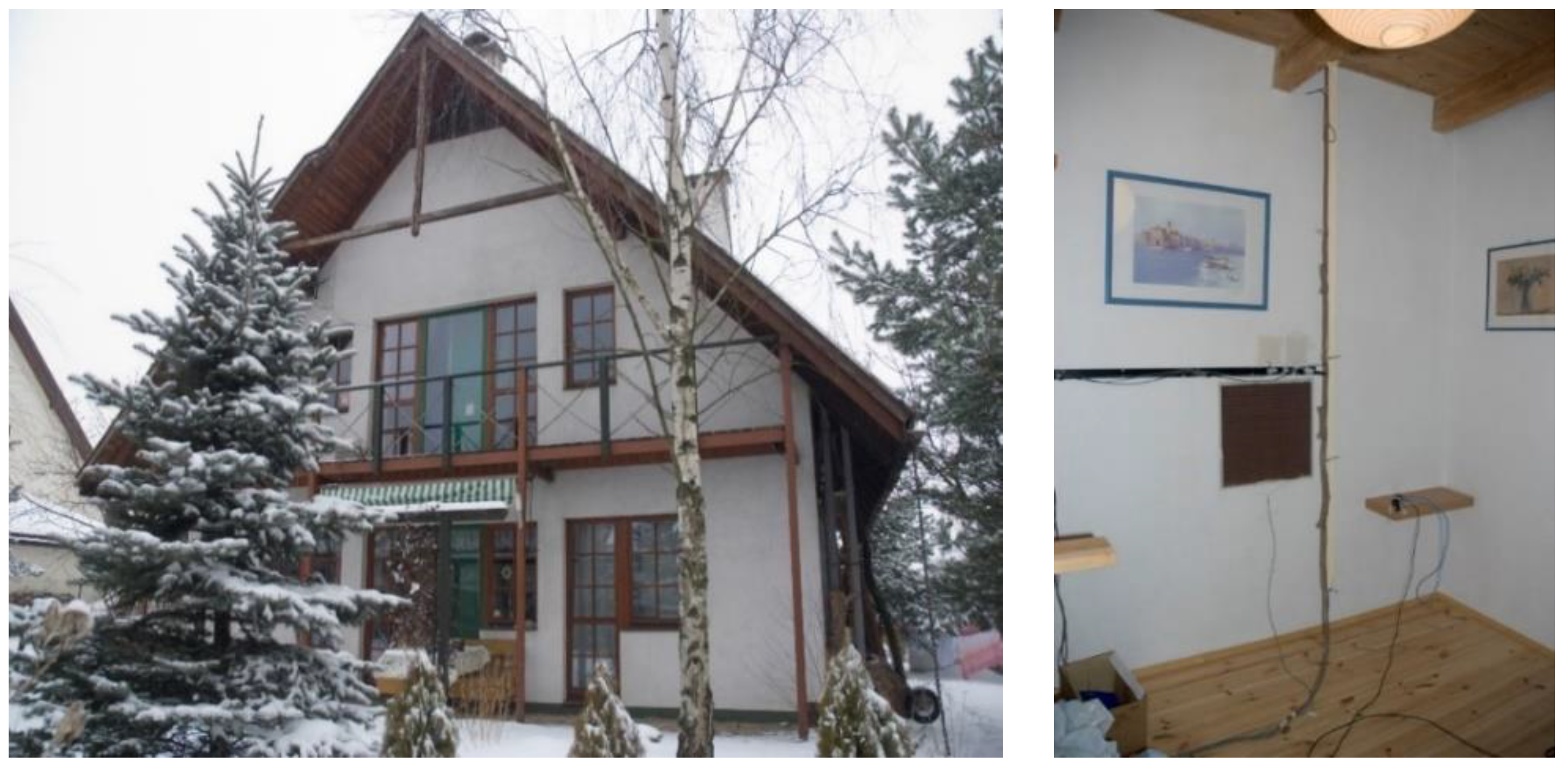

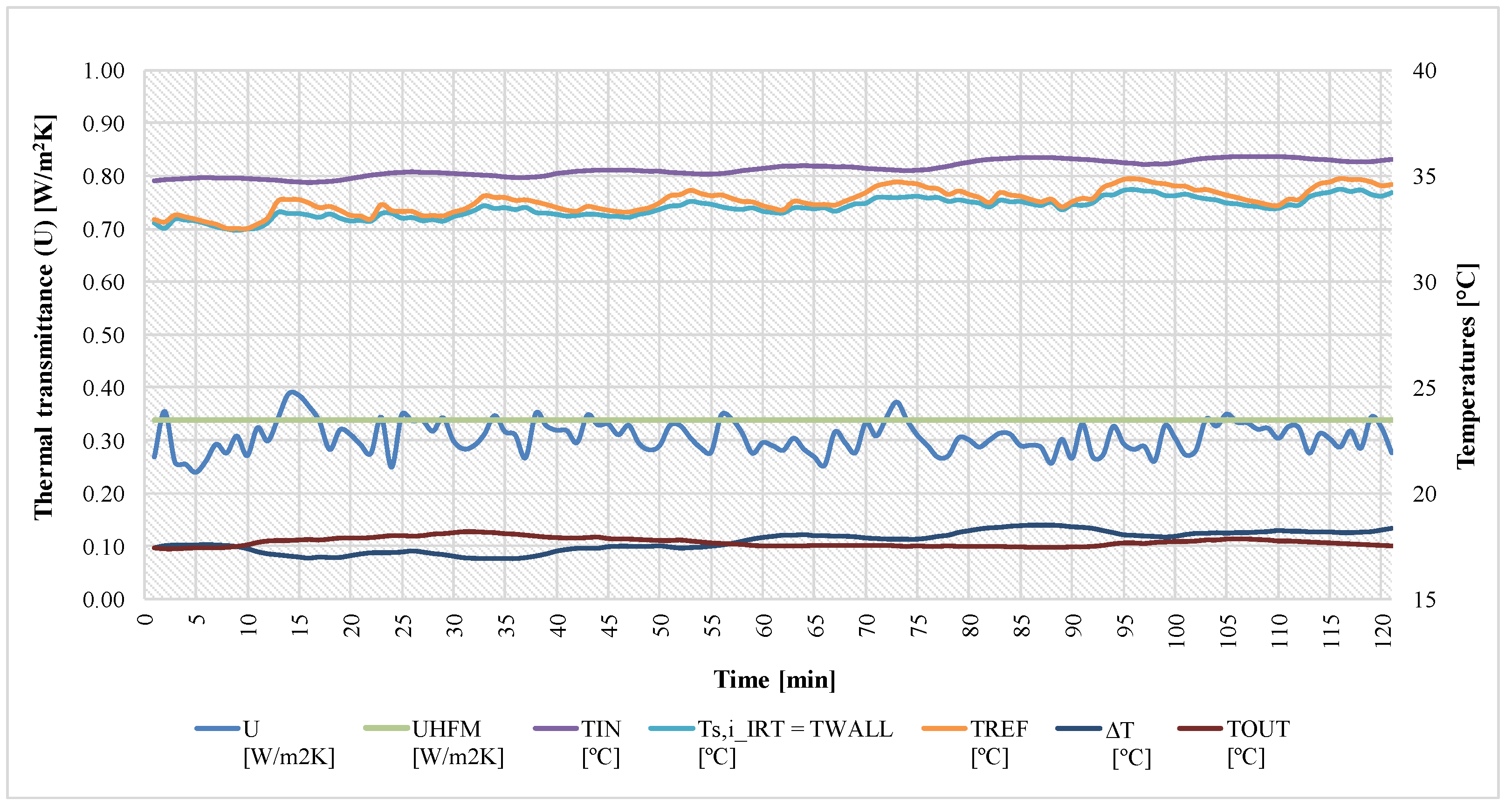
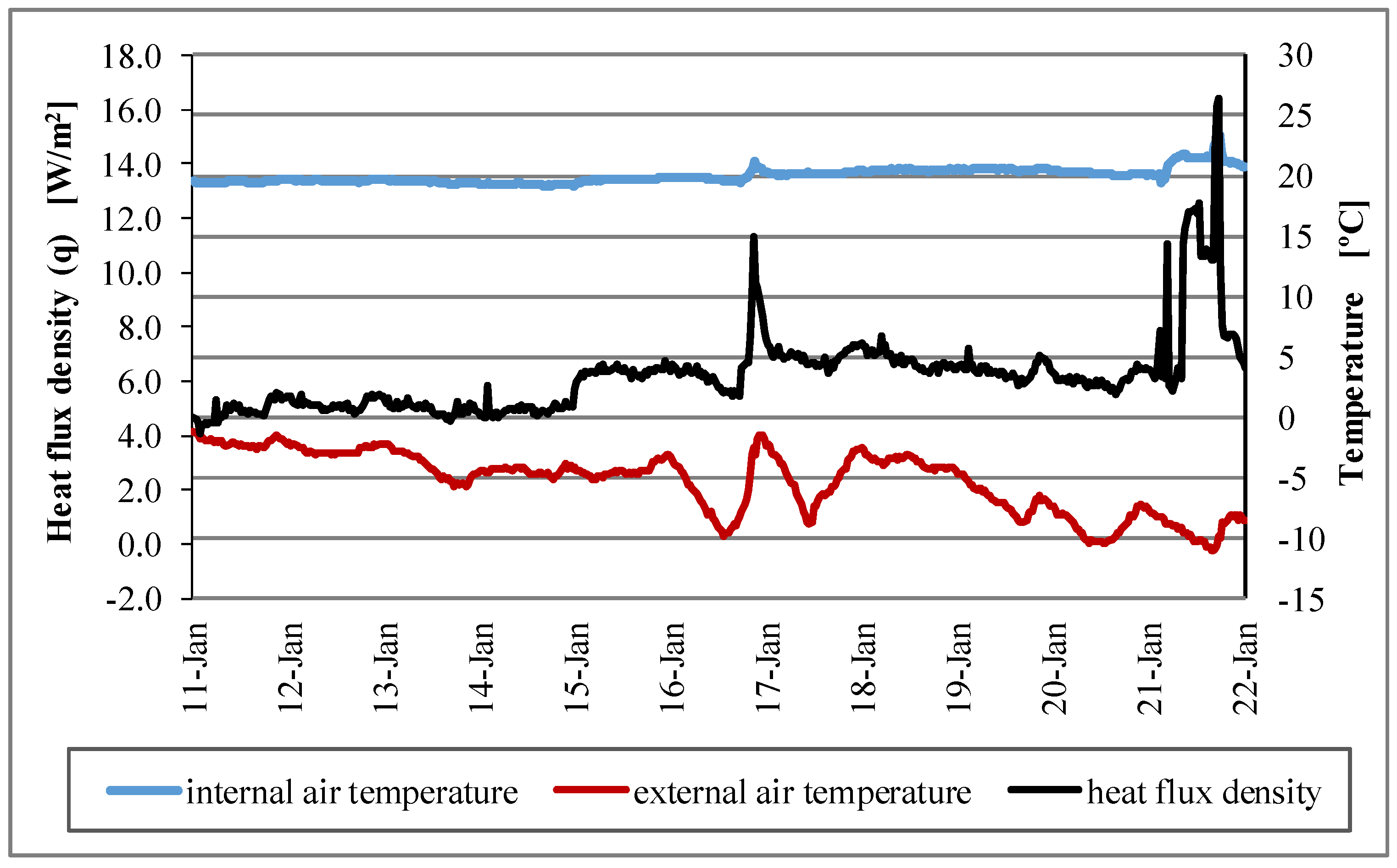
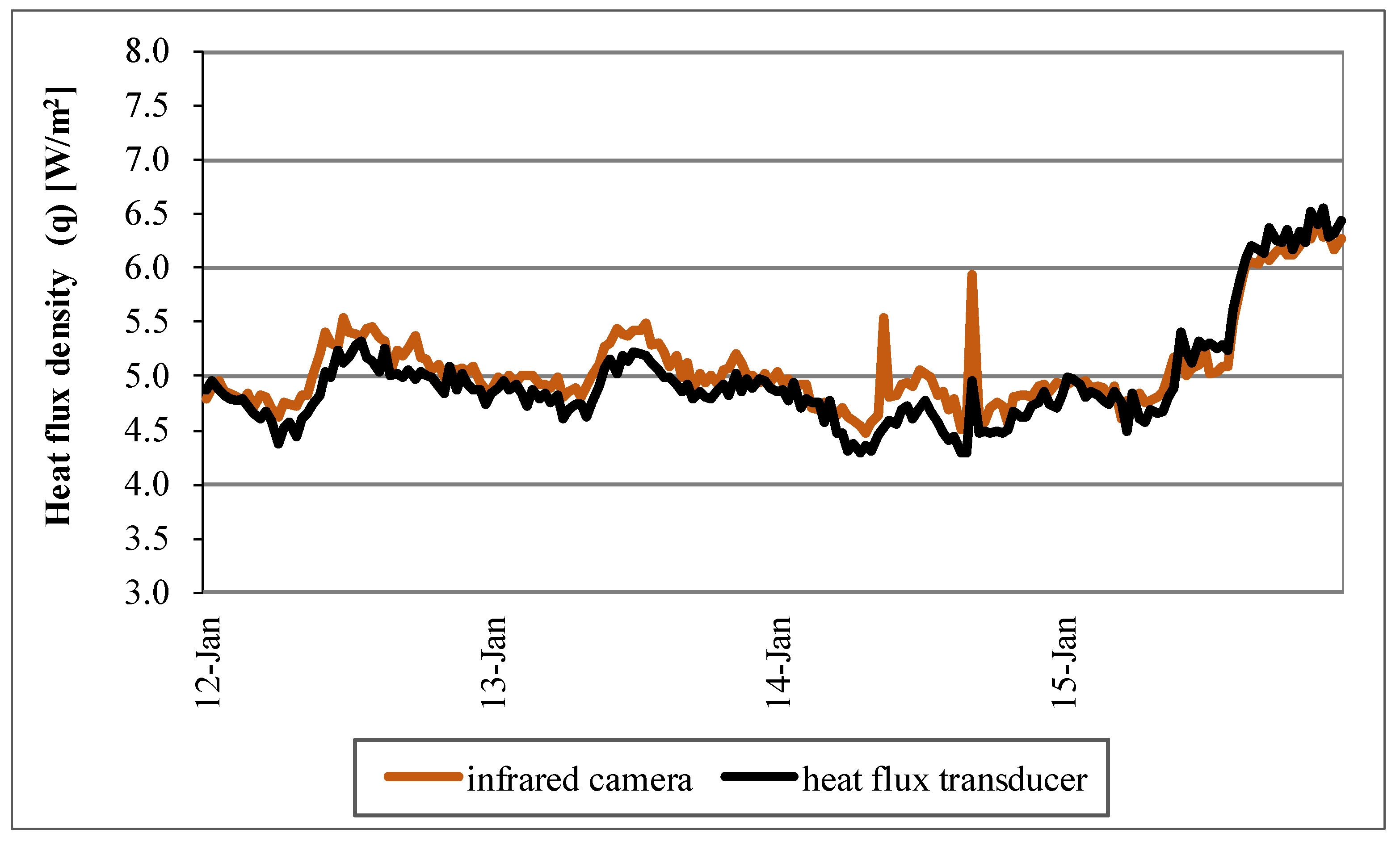


| N# | Material Layer | ∆xi (m) | λi (W/(m·K)) | Rti ((m2·K)/W) | L (m) | Ut (W/(m2·K)) | |
|---|---|---|---|---|---|---|---|
| Mock-up Laboratory (Portugal) | 1 2 3 4 | Lightweight concrete Lightweight mortar Insulation EPS Plasterboard | 0.250 0.010 0.060 0.005 | 0.610 0.037 0.210 | 1.360 | 1.90 | 0.313 |
| Equipment | Operative Range | Resolution | Precision |
|---|---|---|---|
| Climatic Chamber | Temperature: −50 °C to 180 °C | 0.1 | ±0.5 °C |
| Heat flux sensor | Maximum temperature: 90 °C Temperature correction: +0.10%/K Thermal conductivity: 0.25 W/(m·K) Internal electrical resistance: 445–450 Ohm Constant of calibration: 17 | - | ±5% |
| IR camera | Temperature: −20 °C to +100 °C FOV: 21.7° × 16.4° Thermal sensitivity: 0.04 °C at 30 °C | 320 × 240 pixels | ±2 °C or ± 2% reading |
| T sensors | Temperature: −20 °C to 70 °C | 0.024 °C | ±0.21 °C |
| Emissometer | - | - | ±0.01 |
| N# | Material Layer | ∆xi (m) | λi (W/(m·K)) | Rti ((m2·K)/W) | L (m) | Ut (W/(m2·K)) | |
|---|---|---|---|---|---|---|---|
| Detached House (Poland) | 1 2 3 4 | Adhesive + external plaster Expanded polystyrene Silica brickwork (hollow block) Internal lime plaster | 0.005 0.130 0.250 0.020 | 0.800 0.037 0.750 0.800 | 0.006 3.513 0.333 0.025 | 2.5 | 0.244 |
| UQIRT (W/m2·K) | UHFM (W/m2·K) | Ut (W/m2·K) | UQIRT avg (W/m2·K) | UHFM avg (W/m2·K) | ∆U IRT –t/Ut (%) | ∆U HFM –t/Ut (%) | ∆UNDT/UHFM (%) | |
|---|---|---|---|---|---|---|---|---|
| TEST 1 | 0.320 | 0.338 | 0.313 | 0.323 | 0.314 | 3.19 | 0.32 | 2.90 |
| TEST 2 | 0.316 | 0.313 | ||||||
| TEST 3 | 0.334 | 0.292 |
| Type of Test | Mean Heat Flux (W/m2) | Standard Deviation (W/m2) | Difference of Mean Values (W/m2) | Standard Deviation of the Differences (W/m2) | Variability of the Differences of the Mean Heat Flux Value (%) |
|---|---|---|---|---|---|
| Heat transducer | 5.247 | 0.684 | 0.077 | 0.184 | 3.5 |
| Infrared camera | 5.324 | 0.577 |
| Type of Test | Ut (W/m2·K) | UQIRT avg (W/m2·K) | UHFM avg (W/m2·K) | ∆U IRT –t/Ut (%) | ∆U HFM –t/Ut (%) | ∆UNDT/UHFM (%) |
|---|---|---|---|---|---|---|
| Long-lasting test | 0.244 | 0.229 | 0.221 | 6.15 | 9.43 | 3.61 |
Publisher’s Note: MDPI stays neutral with regard to jurisdictional claims in published maps and institutional affiliations. |
© 2020 by the authors. Licensee MDPI, Basel, Switzerland. This article is an open access article distributed under the terms and conditions of the Creative Commons Attribution (CC BY) license (http://creativecommons.org/licenses/by/4.0/).
Share and Cite
Tejedor, B.; Barreira, E.; Peixoto de Freitas, V.; Kisilewicz, T.; Nowak-Dzieszko, K.; Berardi, U. Impact of Stationary and Dynamic Conditions on the U-Value Measurements of Heavy-Multi Leaf Walls by Quantitative IRT. Energies 2020, 13, 6611. https://doi.org/10.3390/en13246611
Tejedor B, Barreira E, Peixoto de Freitas V, Kisilewicz T, Nowak-Dzieszko K, Berardi U. Impact of Stationary and Dynamic Conditions on the U-Value Measurements of Heavy-Multi Leaf Walls by Quantitative IRT. Energies. 2020; 13(24):6611. https://doi.org/10.3390/en13246611
Chicago/Turabian StyleTejedor, Blanca, Eva Barreira, Vasco Peixoto de Freitas, Tomasz Kisilewicz, Katarzyna Nowak-Dzieszko, and Umberto Berardi. 2020. "Impact of Stationary and Dynamic Conditions on the U-Value Measurements of Heavy-Multi Leaf Walls by Quantitative IRT" Energies 13, no. 24: 6611. https://doi.org/10.3390/en13246611
APA StyleTejedor, B., Barreira, E., Peixoto de Freitas, V., Kisilewicz, T., Nowak-Dzieszko, K., & Berardi, U. (2020). Impact of Stationary and Dynamic Conditions on the U-Value Measurements of Heavy-Multi Leaf Walls by Quantitative IRT. Energies, 13(24), 6611. https://doi.org/10.3390/en13246611









